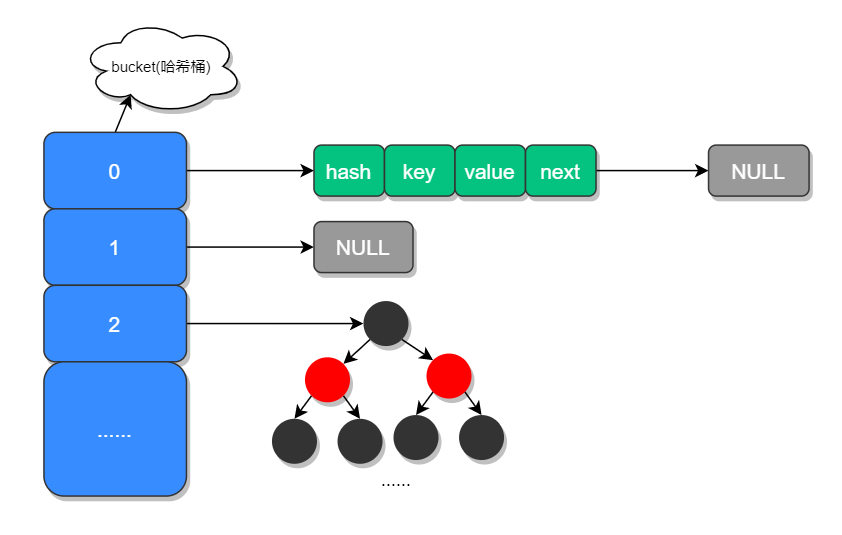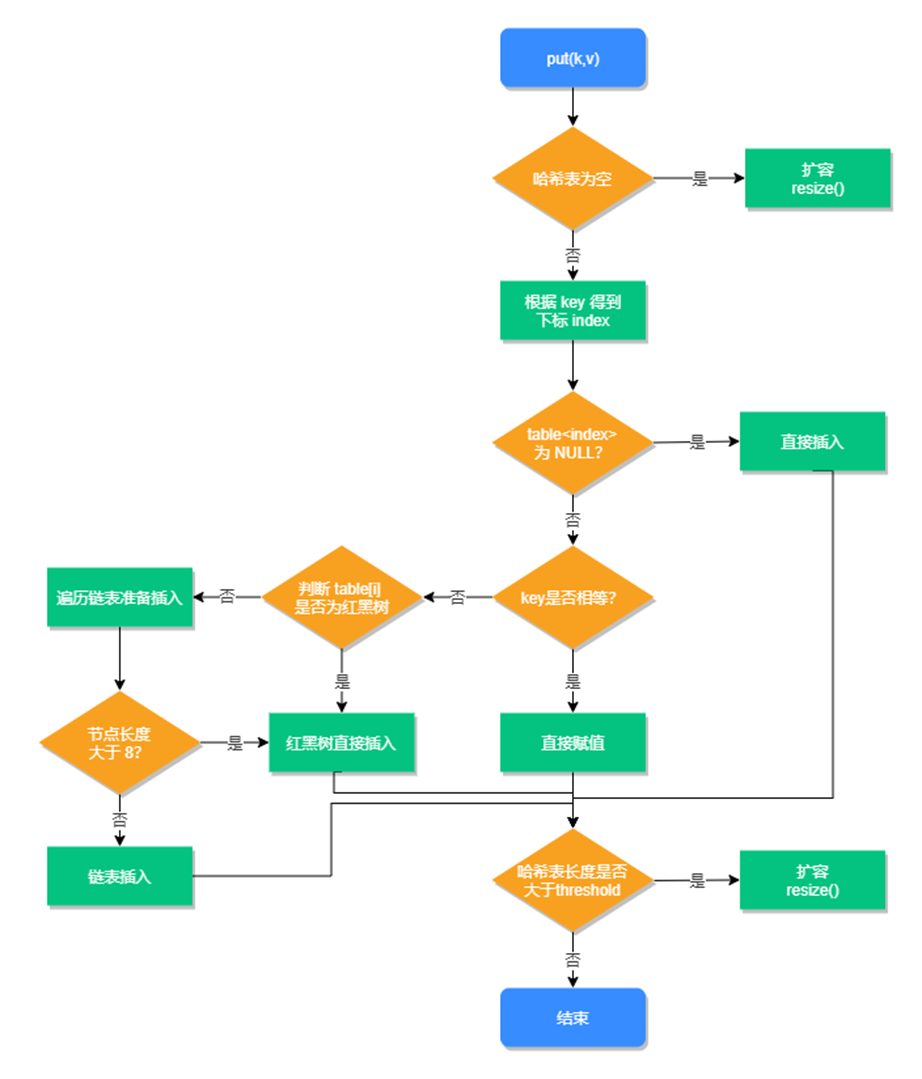【基本结构】
在 JDK 1.7 中 HashMap 是以数组加链表的形式组成的;
JDK 1.8 之后新增了红黑树的组成结构,当链表大于 8 并且容量大于 64 时,链表结构会转换成红黑树结构,它的组成结构如下图所示:

数组中的元素我们称之为哈希桶,它的定义如下:
|
static class Node<K,V> implements Map.Entry<K,V> { final int hash; final K key; V value; Node<K,V> next;
Node(int hash, K key, V value, Node<K,V> next) { this.hash = hash; this.key = key; this.value = value; this.next = next; }
public final K getKey() { return key; } public final V getValue() { return value; } public final String toString() { return key + "=" + value; }
public final int hashCode() { return Objects.hashCode(key) ^ Objects.hashCode(value); }
public final V setValue(V newValue) { V oldValue = value; value = newValue; return oldValue; }
public final boolean equals(Object o) { if (o == this) return true; if (o instanceof Map.Entry) { Map.Entry<?,?> e = (Map.Entry<?,?>)o; if (Objects.equals(key, e.getKey()) && Objects.equals(value, e.getValue())) return true; } return false; } } |
可以看出每个哈希桶中包含了四个字段:hash、key、value、next,其中 next 表示链表的下一个节点。
JDK 1.8 之所以添加红黑树是因为一旦链表过长,会严重影响 HashMap 的性能,而红黑树具有快速增删改查的特点,这样就可以有效的解决链表过长时操作比较慢的问题。
【HashMap 源码分析】
HashMap 源码中包含了以下几个属性:
|
// HashMap 初始化长度 static final int DEFAULT_INITIAL_CAPACITY = 1 << 4; // aka 16
// HashMap 最大长度 static final int MAXIMUM_CAPACITY = 1 << 30; // 1073741824
// 默认的加载因子 (扩容因子) static final float DEFAULT_LOAD_FACTOR = 0.75f;
// 当链表长度大于此值且容量大于 64 时 static final int TREEIFY_THRESHOLD = 8;
// 转换链表的临界值,当元素小于此值时,会将红黑树结构转换成链表结构 static final int UNTREEIFY_THRESHOLD = 6;
// 最小树容量 static final int MIN_TREEIFY_CAPACITY = |
【什么是加载因子?加载因子为什么是 0.75?】
加载因子也叫扩容因子或负载因子,用来判断什么时候进行扩容的,假如加载因子是 0.5,HashMap 的初始化容量是 16,那么当 HashMap 中有 16*0.5=8 个元素时,HashMap 就会进行扩容。
那加载因子为什么是 0.75 而不是 0.5 或者 1.0 呢?
这其实是出于容量和性能之间平衡的结果:
当加载因子设置比较大的时候,扩容的门槛就被提高了,扩容发生的频率比较低,占用的空间会比较小,但此时发生 Hash 冲突的几率就会提升,因此需要更复杂的数据结构来存储元素,这样对元素的操作时间就会增加,运行效率也会因此降低;
而当加载因子值比较小的时候,扩容的门槛会比较低,因此会占用更多的空间,此时元素的存储就比较稀疏,发生哈希冲突的可能性就比较小,因此操作性能会比较高。
所以综合了以上情况就取了一个 0.5 到 1.0 的平均数 0.75 作为加载因子。
【查询源码】
|
public V get(Object key) { Node<K,V> e; // 对 key 进行哈希操作 return (e = getNode(hash(key), key)) == null ? null : e.value; } final Node<K,V> getNode(int hash, Object key) { Node<K,V>[] tab; Node<K,V> first, e; int n; K k; // 非空判断 if ((tab = table) != null && (n = tab.length) > 0 && (first = tab[(n - 1) & hash]) != null) { // 判断第一个元素是否是要查询的元素 if (first.hash == hash && // always check first node ((k = first.key) == key || (key != null && key.equals(k)))) return first; // 下一个节点非空判断 if ((e = first.next) != null) { // 如果第一节点是树结构,则使用 getTreeNode 直接获取相应的数据 if (first instanceof TreeNode) return ((TreeNode<K,V>)first).getTreeNode(hash, key); do { // 非树结构,循环节点判断 // hash 相等并且 key 相同,则返回此节点 if (e.hash == hash && ((k = e.key) == key || (key != null && key.equals(k)))) return e; } while ((e = e.next) != null); } } return null; } |
从以上源码可以看出,当哈希冲突时我们需要通过判断 key 值是否相等,才能确认此元素是不是我们想要的元素。
【新增源码】
|
public V put(K key, V value) { // 对 key 进行哈希操作 return putVal(hash(key), key, value, false, true); } final V putVal(int hash, K key, V value, boolean onlyIfAbsent, boolean evict) { Node<K,V>[] tab; Node<K,V> p; int n, i; // 哈希表为空则创建表 if ((tab = table) == null || (n = tab.length) == 0) n = (tab = resize()).length; // 根据 key 的哈希值计算出要插入的数组索引 i if ((p = tab[i = (n - 1) & hash]) == null) // 如果 table[i] 等于 null,则直接插入 tab[i] = newNode(hash, key, value, null); else { Node<K,V> e; K k; // 如果 key 已经存在了,直接覆盖 value if (p.hash == hash && ((k = p.key) == key || (key != null && key.equals(k)))) e = p; // 如果 key 不存在,判断是否为红黑树 else if (p instanceof TreeNode) // 红黑树直接插入键值对 e = ((TreeNode<K,V>)p).putTreeVal(this, tab, hash, key, value); else { // 为链表结构,循环准备插入 for (int binCount = 0; ; ++binCount) { // 下一个元素为空时 if ((e = p.next) == null) { p.next = newNode(hash, key, value, null); // 转换为红黑树进行处理 if (binCount >= TREEIFY_THRESHOLD - 1) // -1 for 1st treeifyBin(tab, hash); break; } // key 已经存在直接覆盖 value if (e.hash == hash && ((k = e.key) == key || (key != null && key.equals(k)))) break; p = e; } } if (e != null) { // existing mapping for key V oldValue = e.value; if (!onlyIfAbsent || oldValue == null) e.value = value; afterNodeAccess(e); return oldValue; } } ++modCount; // 超过最大容量,扩容 if (++size > threshold) resize(); afterNodeInsertion(evict); return null; } |
新增方法的执行流程,如下图所示:

【扩容源码】
|
final Node<K,V>[] resize() { // 扩容前的数组 Node<K,V>[] oldTab = table; // 扩容前的数组的大小和阈值 int oldCap = (oldTab == null) ? 0 : oldTab.length; int oldThr = threshold; // 预定义新数组的大小和阈值 int newCap, newThr = 0; if (oldCap > 0) { // 超过最大值就不再扩容了 if (oldCap >= MAXIMUM_CAPACITY) { threshold = Integer.MAX_VALUE; return oldTab; } // 扩大容量为当前容量的两倍,但不能超过 MAXIMUM_CAPACITY else if ((newCap = oldCap << 1) < MAXIMUM_CAPACITY && oldCap >= DEFAULT_INITIAL_CAPACITY) newThr = oldThr << 1; // double threshold } // 当前数组没有数据,使用初始化的值 else if (oldThr > 0) // initial capacity was placed in threshold newCap = oldThr; else { // zero initial threshold signifies using defaults // 如果初始化的值为 0,则使用默认的初始化容量 newCap = DEFAULT_INITIAL_CAPACITY; newThr = (int)(DEFAULT_LOAD_FACTOR * DEFAULT_INITIAL_CAPACITY); } // 如果新的容量等于 0 if (newThr == 0) { float ft = (float)newCap * loadFactor; newThr = (newCap < MAXIMUM_CAPACITY && ft < (float)MAXIMUM_CAPACITY ? (int)ft : Integer.MAX_VALUE); } threshold = newThr; @SuppressWarnings({"rawtypes","unchecked"}) Node<K,V>[] newTab = (Node<K,V>[])new Node[newCap]; // 开始扩容,将新的容量赋值给 table table = newTab; // 原数据不为空,将原数据复制到新 table 中 if (oldTab != null) { // 根据容量循环数组,复制非空元素到新 table for (int j = 0; j < oldCap; ++j) { Node<K,V> e; if ((e = oldTab[j]) != null) { oldTab[j] = null; // 如果链表只有一个,则进行直接赋值 if (e.next == null) newTab[e.hash & (newCap - 1)] = e; else if (e instanceof TreeNode) // 红黑树相关的操作 ((TreeNode<K,V>)e).split(this, newTab, j, oldCap); else { // preserve order // 链表复制,JDK 1.8 扩容优化部分 Node<K,V> loHead = null, loTail = null; Node<K,V> hiHead = null, hiTail = null; Node<K,V> next; do { next = e.next; // 原索引 if ((e.hash & oldCap) == 0) { if (loTail == null) loHead = e; else loTail.next = e; loTail = e; } // 原索引 + oldCap else { if (hiTail == null) hiHead = e; else hiTail.next = e; hiTail = e; } } while ((e = next) != null); // 将原索引放到哈希桶中 if (loTail != null) { loTail.next = null; newTab[j] = loHead; } // 将原索引 + oldCap 放到哈希桶中 if (hiTail != null) { hiTail.next = null; newTab[j + oldCap] = hiHead; } } } } } return newTab; } |
从以上源码可以看出,JDK 1.8 在扩容时并没有像 JDK 1.7 那样,重新计算每个元素的哈希值,而是通过高位运算(e.hash & oldCap)来确定元素是否需要移动,比如 key1 的信息如下:
key1.hash = 10 0000 1010
oldCap = 16 0001 0000
使用 e.hash & oldCap 得到的结果,高一位为 0,当结果为 0 时表示元素在扩容时位置不会发生任何变化,而 key 2 信息如下:
key2.hash = 10 0001 0001
oldCap = 16 0001 0000
这时候得到的结果,高一位为 1,当结果为 1 时,表示元素在扩容时位置发生了变化,新的下标位置等于原下标位置 + 原数组长度,如下图所示:

其中红色的虚线图代表了扩容时元素移动的位置。
【HashMap 死循环分析】
以 JDK 1.7 为例,假设 HashMap 默认大小为 2,原本 HashMap 中有一个元素 key(5);
我们再使用两个线程:t1 添加元素 key(3),t2 添加元素 key(7);
当元素 key(3) 和 key(7) 都添加到 HashMap 中之后,线程 t1 在执行到 Entry<K,V> next = e.next; 时,交出了 CPU 的使用权,源码如下:
|
void transfer(Entry[] newTable, boolean rehash) { int newCapacity = newTable.length; for (Entry<K,V> e : table) { while(null != e) { Entry<K,V> next = e.next; // 线程一执行此处 if (rehash) { e.hash = null == e.key ? 0 : hash(e.key); } int i = indexFor(e.hash, newCapacity); e.next = newTable[i]; newTable[i] = e; e = next; } } } |
那么此时线程 t1 中的 e 指向了 key(3),而 next 指向了 key(7) ;之后线程 t2 重新 rehash 之后链表的顺序被反转,链表的位置变成了 key(5) → key(7) → key(3),其中 "→" 用来表示下一个元素。
当 t1 重新获得执行权之后,先执行 newTalbe[i] = e 把 key(3) 的 next 设置为 key(7),而下次循环时查询到 key(7) 的 next 元素为 key(3),于是就形成了 key(3) 和 key(7) 的循环引用,因此就导致了死循环的发生,如下图所示:

当然发生死循环的原因是 JDK 1.7 链表插入方式为首部倒序插入,这个问题在 JDK 1.8 得到了改善,变成了尾部正序插入。
有人曾经把这个问题反馈给了 Sun 公司,但 Sun 公司认为这不是一个问题,因为 HashMap 本身就是非线程安全的,如果要在多线程下,建议使用 ConcurrentHashMap 替代,但这个问题在面试中被问到的几率依然很大,所以在这里需要特别说明一下。
from:Java 源码剖析(https://kaiwu.lagou.com/course/courseInfo.htm?courseId=59#/detail/pc?id=1761)